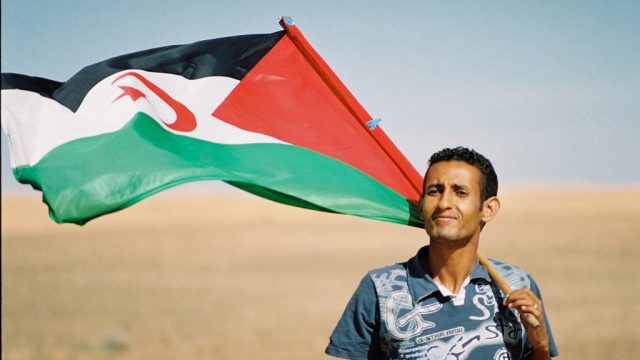The Western Sahara is one of the last remaining territories in the world that is non-self governing by U.N. definitions. The Sahrawi people living there have endured decades of conflict and uncertainty, with self determination still out of their grasp. But as the political situation remains in limbo, life goes on. Here are 12 things you didn’t know about the Sahrawi of Western Sahara.
Sources: AllAfrica.com, NYTimes.com, JoshuaProject.net, BBC.com, WaronWant.org, EJAtlas.org, GreenLeft.org.au
This article originally appeared on AFKInsider.com.
Thousands were forced out of their homes in 1975
Despite an International Court of Justice mandate that recognized the Saharawi right to self-determination in October 1975, Moroccan and Mauritanian troops invaded the territory the following month and blocked a referendum. Instead, the Madrid Agreement was signed, partitioning the region between Morocco and Mauritania and ending Spanish colonial rule, but leaving the Sahrawi without the rights to their land and vulnerable to being forced from their homes, sometimes with the use of napalm.
The Sahrawi people established the Polisario Front to fight Moroccan forces
The Sahrawi fought back against Moroccan occupation, establishing the Polisario Front – a national liberation movement that would settle for nothing less than self rule. Though a ceasefire stopped the fighting in 1991 when the U.N. promised that a referendum on self-determination would be granted, the Polisario Front is still fighting for international recognition.
The SADR has been formally recognized by a small fraction of the world
To date, 53 states have formally recognized the Sahrawi Arab Democratic Republic, or SADR – the Polisario Front’s claim to the Western Sahara region. The SADR was also extended membership to the African Union in 1984 when Morocco withdrew from the A.U.’s predecessor, the Organization of African Unity. The Polisario Front maintains government headquarters in exile in Tindouf, Algeria, where it administers the Sahrawi refugee camps.
Many Sahrawi live in refugee camps, waiting to return home
After 1975, many Sahrawi people fled to the deserts in neighboring Algeria, waiting to return home once it was safe and they were returned their rights. More than 165,000 Sahrawi people live in the refugee camps in Tindouf, Algeria, an inhospitable area of the Sahara desert.
Moroccan income from Western Saharan resources exceeds aid it provides refugees
The vast resources of fish and phosphates, as well as oil in the Western Sahara make it an economically valuable region that Morocco is loath to let go. Four million tons of phosphates are transported to Morocco from BuCraa each year, providing over $1.7 billion USD annually. Refugees in the region, however, rarely see much, if any, of this wealth.
The Sahrawi have a female-dominated society
When the Sahrawi fled the Western Sahara for Tindouf, many men stayed behind to fight, leaving the women to establish camps. As one women described, “The women literally built the camps, the little homes, the schools, the facilities, meager as they were. They did everything in and outside of the home. They put up the tents and made them habitable. They created a community when people felt they had none.” Even when the men returned, women had already cemented their place as leaders in Sahrawi society and continue to largely run education and social services.
Plans for a multiparty, post-independence democracy
As the Sahrawi have set up a government in the Tindouf refugee camps, they have already begun to lay the groundwork for government once they achieve independence and are able to return to the Western Sahara. Camp officials say they will introduce a multiparty democracy.
The Sahrawi are Sunni Muslims
The vast majority of Sahrawi people are Sunni Muslim, and most women wear traditional Islamic dress, though they are free to wear Western-style dress if they choose. Certain lineages among the Sahrawi people are said to be descended from the Prophet Mohammed.
They are considered native Berber Arabs
The Sahrawi people are of Arab and Berber descent, and were influenced by the invasion of the Beni Hassan Arab Bedouin tribes, who merged with the indigenous populations that included black Africans and the dominant Sanhaja Berber tribes. The largest Sahrawi tribe, the Reguibat, is noted for nomadic and warrior traditions more in line with Arab identities.
The FiSahara International Film Festival is held annually in a Sahrawi refugee camp
Each year, industry leaders join the Sahrawi people in an Algerian refugee camp for screenings, concerts, cultural activities, and more at the FiSahara International Film Festival. It not only provides immense opportunities for education for the Sahrawi people, but also the chance to educate and raise awareness about their struggle, as well as the ongoing humanitarian crises that exist in the refugee camps.
The Sahrawi people refuse to agree to Moroccan autonomy
Morocco has long avoided the referendum that would give the Sahrawi people an independent state, instead insisting on autonomy within the Kingdom of Morocco. International parties have also been reluctant to force Morocco to agree to a referendum. Morocco is an important trading partner for many countries that have attempted to involve themselves in the peace process.
The Sahrawi remain committed to independence
Despite 40 years passing since the Sahrawi were forced out of their homes, they are still waiting to return and remain committed to the belief that the only answer is independence. Even those who were born in Tindouf and have never set foot in their homeland have expressed willingness to fight for the cause. Though everyone would prefer a peaceful solution to the conflict, the Sahrawi people said they are willing to die for their home.
Want to discover the finer side of Africa? Sign up for our weekly newsletter.

